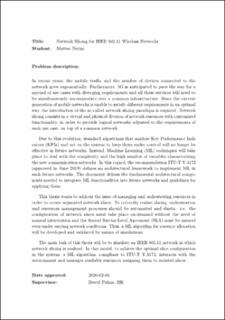| dc.description.abstract | Future networks will pave the way for a myriad of applications with different requirements. In such a context, the today's \emph{one-size-fits-all} approach will not be able to efficiently address the different demands that verticals impose in terms of \gls{qos} and involved data volumes. To this end, network slicing is a new network paradigm which may provide the needed flexibility. It allows to offer multiple logical networks over a common infrastructure, tailored to the services which run on the network.
In today's Wi-Fi networks, all the users are connected to the same wireless channel, which allows service differentiation only at the traffic level. Thus, in this study we propose a standard-compliant network slicing approach for the radio access segment of Wi-Fi, often neglected by the literature on network slicing.
We present two algorithms to realize network slicing at the access level. The first assigns resources according to the requirements of the slices in a static way. On the other hand, the second, more advanced, dynamically configures the slices according to the network conditions and relevant \glspl{kpi}. These techniques can be applied to the IEEE 802.11 standard and, in general, to all the protocols that use \gls{csma} as channel access technique.
The proposed algorithms were validated through extensive simulations, conducted with \emph{ns-3} network simulator and accompanied by theoretical calculations. Particular attention, often neglected in similar simulation-based works, has been paid to the electromagnetic properties of the spectrum, which play a fundamental role in radio communications.
From the conducted simulations, we found that our slicing approaches largely outperform the today's Wi-Fi access technique. They allow to reach higher goodput (i.e. a lower error probability) and lower latency, when needed. At the same time, tailored slicing saves energy to low-power devices and increases the spectrum efficiency. | |
